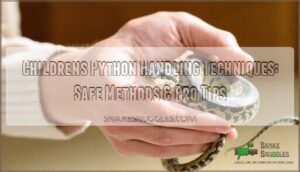This site is supported by our readers. We may earn a commission, at no cost to you, if you purchase through links.
 Children’s python handling techniques require patience and proper support.
Children’s python handling techniques require patience and proper support.
You’ll want to move slowly when approaching your snake, letting them sense your presence first.
Support their body weight with both hands – one behind the head, another mid-body.
Never grab or squeeze.
Handle during their active evening hours, not when they’re shedding or digesting food.
Keep sessions short, around 10-15 minutes max.
Watch for stress signals like hissing or defensive coiling.
Temperature matters too – cold snakes are sluggish and more likely to bite.
Most handling mishaps stem from rushing the process or ignoring your python’s body language signals.
Table Of Contents
Key Takeaways
- Move slowly and support their entire body – You’ll need to use both hands (one behind the head, another mid-body) and approach with deliberate movements to prevent defensive strikes and spine injury.
- Handle during evening hours when they’re active – You should avoid handling when they’re shedding, digesting food, or cold, keeping sessions to 10-15 minutes maximum.
- Watch for stress signals and respect boundaries – You’ll recognize hissing, defensive coiling, and rigid posturing as signs to stop handling immediately and give your snake space.
- Create proper environmental conditions first – You need secure enclosures, consistent temperatures (75-88°F), and 50-60% humidity to ensure your python stays calm and predictable during handling.
Handling Children’s Pythons
You’ll find that children’s pythons respond best to slow and deliberate movements when you approach them for handling.
Patience with pythons pays off—sudden moves trigger defensive strikes that damage trust forever.
These small Australian natives require confident but gentle contact to prevent defensive responses that can make future interactions more difficult.
Gentle Handling Techniques
Mastering snake wrangling requires a gentle touch that prioritizes python care and child safety. Approach your python with deliberate, slow movements to prevent triggering defensive responses.
Essential handling tips for safe interaction:
- Move slowly and predictably – jerky motions trigger stress responses
- Approach from the side – overhead movements startle pythons
- Use soft grip techniques – maintain loose, supportive contact
Wait until your python feeds regularly before attempting handling. Like preventing contagious illness outbreaks, proper technique prevents defensive behaviors and stress symptoms from developing. Handling ball pythons requires understanding post feeding care to guarantee their health and well-being.
Supporting The Body
You support a python’s entire body weight using both hands.
Never let gravity stress their spine or ribs. Place one hand behind the head, the other mid-body.
This Body Support protects their Joint Health and prevents muscle strain.
Proper handling guarantees Bone Strength and Skin Protection, keeping your snake comfortable and secure during interaction.
Avoiding Restraint
Never let your python feel trapped when handling them.
Restraint-free techniques keep your snake calm and cooperative, preventing defensive behaviors that lead to stress.
- Allow natural movement – Let your python shift positions and explore rather than holding them rigidly in place
- Use gentle touch methods – Support their body weight without gripping or constraining their natural coiling motions
- Practice stress reduction approaches – Watch for tension signs and give breaks during handling sessions
Python Safety Precautions
Your safety depends on preparation before any python interaction.
Preparation today prevents python emergencies tomorrow.
Python First Aid supplies should stay within arm’s reach – antiseptic, bandages, and emergency contact numbers.
Snake Bite Prevention starts with proper Python Handling Tools: hook sticks, tubes, and thick gloves rated for reptile work.
Safety Equipment isn’t optional when working with these powerful constrictors.
You’ll need escape-proof containers, secure transport boxes, and backup restraint tools.
Emergency Response protocols should be rehearsed regularly – know your nearest hospital’s location and their snakebite treatment capabilities.
Professional handlers often compare python safety to grief support work – both require patience, respect, and understanding that unpredictable situations arise.
Like child life specialists who adapt to each patient’s needs, you must read your python’s body language and stress signals.
Consider consulting experts in palliative care fields who understand risk management, or reach out to your local medical examiner’s office for emergency contact protocols.
Social work professionals often emphasize preparation over reaction – the same principle applies here.
To minimize risks, it’s necessary to follow proper safe feeding guidelines.
Remember: prevention beats cure every time.
Creating a Safe Environment
Your snake’s environment directly impacts its behavior and your safety during handling sessions.
A properly designed habitat prevents escapes and maintains the stable conditions that keep children’s pythons calm and predictable.
Escape-Proof Enclosures
Your python’s enclosure materials determine success or failure. Choose sturdy PVC, HDPE, or glass construction over flimsy aquarium tanks.
Secure lids with wire locks prevent breakouts—never rely on tape. Install proper ventilation systems with mesh smaller than your snake’s head.
Quality locking mechanisms like double-screw systems outperform single locks. Effective escape prevention requires sealed cord holes and silicone-caulked gaps.
Proper enclosure design considers species specific needs for a healthy environment, ensuring proper ventilation and secure lids are in place to create a safe habitat.
Temperature Control
When maintaining precise temperatures, your python’s wellbeing depends on meticulous thermal control.
Here’s your temperature checklist:
- Heat Sources: Position ceramic heaters or under-tank heat pads on one side
- Thermal Gradients: Create 78-88°F warm side, 75-80°F cool side
- Cold Spots: Guarantee basking areas don’t exceed 90°F
- Temperature Sensors: Use digital thermometers with probes for accuracy
- Heat Lamps: Avoid overhead heating that disrupts natural behavior patterns
This systematic approach mirrors pediatric care principles—consistent monitoring prevents health complications.
Accurate temperature readings rely on using a digital thermometer to guarantee the environment is safe for your python.
Humidity Management
You’ll need precise moisture control in your snake enclosures to create an ideal humid microclimate.
Children’s pythons thrive with 50-60% humidity levels, maintained through water bowls and substrate misting.
Poor air quality from excessive moisture can cause respiratory issues, so it’s crucial to monitor and regulate the climate accurately, using tools such as hygrometers for climate regulation monitoring.
While machine learning and natural language processing help modern terrarium systems analyze environmental data through text analysis and sentiment analysis of equipment readings, your hands-on observation remains essential for proper moisture control.
Common Handling Mistakes
Even experienced handlers make critical errors that can harm both you and your children’s python.
These mistakes range from over-handling stressed snakes to using improper support techniques that can injure their delicate spines.
Over-Handling
Many handlers unknowingly create handling stress through excessive contact.
Over-handling causes snake fatigue, leading to defensive behaviors like constant hissing and striking.
Your python needs downtime between sessions to prevent reptile burnout.
Limit handling to twice weekly for juveniles, avoiding the day before and after feeding.
Excessive handling weakens immunity and triggers food refusal.
Proper handling techniques, such as recognizing snake stress signs, are essential for a safe and enjoyable experience, including reptile burnout, handling stress, snake fatigue, and proper handling techniques.
Inadequate Support
Improper support systems can spell disaster for your python’s spine and ribs.
You’ll create handling errors by gripping too tightly or supporting only one body section.
Snake welfare depends on distributing their weight evenly across your hands and arms, using both hands – one behind the head, another mid-body.
These care standards prevent injury and build trust through consistent, gentle support.
Incorrect Temperature
Temperature mistakes can kill your Children’s Python faster than you’d think.
Cold hands create immediate stress, while overheated rooms trigger dangerous behaviors.
You’re literally shocking their system when temperatures swing wildly during handling sessions.
Temperature Control essentials:
- Keep room temperature between 75-80°F before handling
- Warm your hands under lukewarm water first
- Never handle during their basking period (thermal burns risk)
Cold Shock from chilled hands causes immediate hypothermia risk.
Heat Stress from excessive warmth makes pythons aggressive and unpredictable.
Master these childrens python handling techniques to prevent temperature-related accidents.
Advanced Handling Techniques
Once you’ve mastered basic handling, you’ll want to tackle more challenging situations with your children’s python.
These advanced techniques focus on reading your snake’s behavior, building lasting trust, and safely managing defensive responses through patience and proper approach methods, which require patience.
Taming Aggressive Pythons
Some aggressive pythons respond well to gradual desensitization techniques.
Start by sitting near their enclosure daily, letting them adjust to your presence and scent.
Use snake hooks or tongs for initial contact to avoid triggering defensive strikes.
Monitor python behavior closely – raised heads and "S" coils signal stress.
Handle consistently but avoid over-handling, which can worsen aggression and delay progress.
Effective snake handling requires proper use of snake hook tools to guarantee safety.
Recognizing Stress Signs
When your python’s body language shifts from relaxed to tense, you’re witnessing stress signals in real-time.
Watch for rapid head retraction, excessive tongue flicking, and defensive posturing. These behavioral cues indicate your snake needs immediate relief from current stressors.
Hissing, escape attempts, and rigid muscles signal distress requiring health checks and environmental adjustments.
Recognizing stress warning signs is essential for maintaining a healthy and calm environment for your pet snake.
Building Trust With Pythons
Building trust with your children’s python requires patience and consistency.
Start with Scent Familiarization by letting the snake recognize your smell through clothing items.
Use Positive Reinforcement during each Consistent Interaction, offering treats after successful handling sessions.
Gradual Introduction works best – begin with brief touches before full contact.
Master Reading Body Language to understand your python’s comfort level.
These trust-building techniques transform defensive snakes into calm companions over time.
Frequently Asked Questions (FAQs)
Do children’s pythons like to be held?
Studies show 90% of children’s pythons are calm when handled.
You’ll find these docile snakes tolerate handling well with gradual introduction, though each snake has its own personality—some are extremely placid while others show more spirit.
What feeding schedule works best for pythons?
You’ll want to feed juvenile pythons weekly, while adults thrive on bi-weekly meals. Offer appropriately-sized prey—nothing wider than your snake’s thickest section. Consistency beats perfection here.
How do you transport pythons safely?
Use secure ventilated containers with tight-fitting lids. Maintain proper temperature ranges during transport. Handle containers gently to minimize stress. Never transport pythons in makeshift containers—they’re escape artists extraordinaire.
When should you avoid handling your python?
Avoid handling your python during shedding, after feeding (wait 48-72 hours), when they’re in defensive posture, during breeding season, or if you’re stressed—snakes sense tension and react accordingly.
What tools help with python handling?
Hook tools and tubes simplify handling safely. You’ll need snake hooks for lifting, clear tubes for restraint, and proper gloves. These tools let you maintain distance while controlling movement effectively.
How do you introduce children to pythons?
Start with calm movements and let children observe from a safe distance first.
You’ll build confidence by explaining the snake’s behavior while demonstrating proper grip techniques.
Always supervise closely and make certain the python’s temperament suits interaction, ensuring a safe and educational experience with a suitable temperament.
Conclusion
Mastering children’s python handling techniques is like learning to dance with a partner who speaks through body language alone.
You’ll develop confidence through consistent practice and careful observation. Remember that every python has unique preferences and temperaments.
Start slowly, respect their boundaries, and never rush the bonding process. These skills improve with time and patience.
Your snake will respond positively to gentle, predictable interactions. Most handling success comes from reading their subtle cues correctly.
- https://geminipythons.com/children-ball-pythons/
- https://reptifiles.com/ball-python-care-guide/ball-python-handling-tips/
- https://icwdm.org/species/reptiles/snakes/snake-damage-prevention-and-control-methods/
- https://www.youtube.com/watch?v=t91XMvAD5Js
- https://www.petassure.com/maxscorner/pet-python-safety-concerns/














